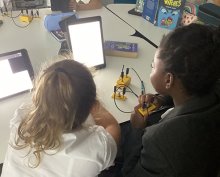
Do you know your ciphertext from your plaintext? Year 5 can help you there! They have been very excited to start their Computer Science topic in cryptography (the art of writing or solving codes) with Ms Davies (Computer Science teacher).
The first week they began with pondering how messages might have been sent over long distances before the invention of the telephone. This led to discovery of how the postal service works, and how pigeons could be used to carry messages (sadly not quite the same as owls in Harry Potter). Year 5 were then keen to grab some flags and had a go at sending words and short messages using semaphore.
The next lesson we investigated a binary code, Morse, using simple circuits and lamps. We then looked at what a telegraph machine was, and learned about the inventors Alfred Vail and Samuel Morse. We made predictions why the letters T and E have short codes and letters like Q and Z have longer codes. This led us to letter frequency in the English language. Knowing the letter E is the most frequently used letter has helped us crack each week’s secret message!
Most recently we have explored substitution ciphers, one used by Roman Emperor Caesar, and one called Pigpen. However, we know that these are not very secure and can be broken once the cipher is known, or by using a brute force attack.
Each week we link our cryptography experience back to real life computing examples, such as how networks work, packets are switched, instructions are sent in binary and files are encrypted.
Follow the Computer Science Department Twitter @BGSICT to keep up with what we do next.





















